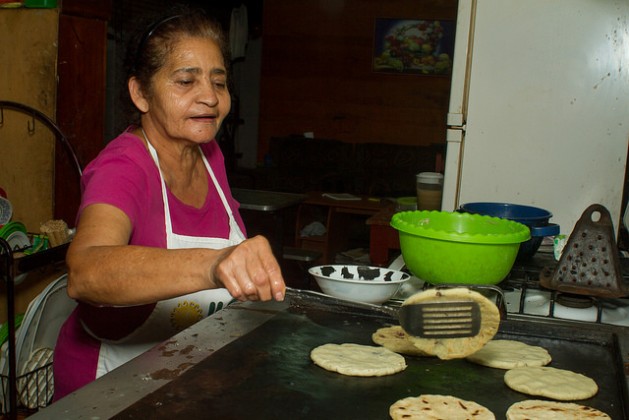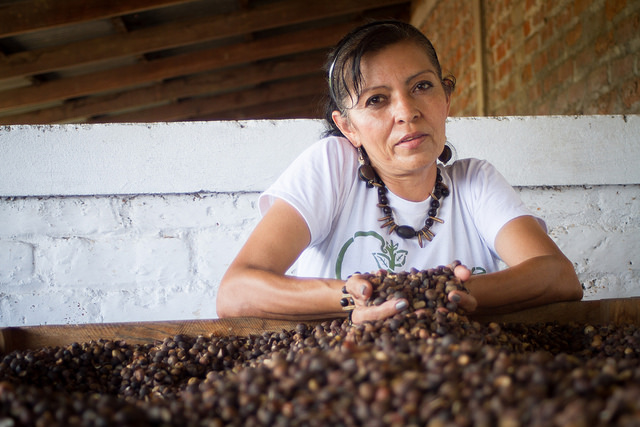Native Plants Boost Local Diets in El Salvador

SAN ISIDRO, El Salvador, Aug 09 (IPS) - Juana Morales is cooking one of the most popular dishes in El Salvador: pupusas, corn tortillas with different fillings. But hers are unique: they are not made with the traditional corn tortillas, but use Maya nuts, a highly nutritional seed that has fallen out of use but whose consumption is being encouraged in rural communities.
"I cook something with ojushte almost every day - pupusas, tamales (seasoned meat packed in cornmeal dough and wrapped and steamed in corn husks) orlittle cakes; it's an excellent food," the 65-year-old Salvadoran woman told IPS, standing in her kitchen in San Isidro, a small town of 3,000 people in the municipality of Izalco in the western department of Sonsonate.
Pupusas are made with thick tortillas and filled with beans, cheese, vegetables or pork.
Juana Morales has easy access to ojushte (Brosimum alicastrum) because her daughter Ana Morales is the leading local advocate of the nutritional properties of the seed in San Isidro, thanks to the work carried out by a local organisation.
Maná Ojushte is a women's collective that emerged in San Isidro and began to promote the Maya nut tree and its seeds in 2010, an initiative that received a major boost in 2014 when it began to receive support from the Initiative Fund for the Americas El Salvador (FIAES), a U.S.-Salvadoran environmental conservation organisation.
The seeds of the Ojushte or Maya nut tree are beginning to be used in San Isidro and other communities in this Central American nation as an alternative source of nutrients for rural families, as part of projects designed to fight the impacts of climate change.
Still rare, the tree is found in the Salvadoran countryside, and in pre-Hispanic times it formed an important part of the diet of indigenous peoples throughout Central America and Mexico, said Ana Morales, the head of Maná Ojushte.
The seeds, she explained, contain high levels of protein, iron, zinc, vitamins, folic acid, calcium, fiber and tryptophan, an amino acid, which makes them an excellent addition to the family diet.
"It's compared to soy, but it has the advantage of being gluten-free and low in fat," Ana Morales told IPS.
Support from FIAES forms part of the conservation plans for the Apaneca Lamatepec Biosphere Reserve, which covers more than 132,000 hectares in 23 municipalities in the western Salvadoran departments of Ahuachapán, Santa Ana and Sonsonate.
"With the work in the reserve, we have tried to link cultural aspects with the health and nutrition of local communities, and revive consumption of this seed, which was part of our ancestral heritage," FIAES territorial coordinator Silvia Flores told IPS.
Maná Ojushte, run by a core group of 10 women, sells Maya nuts, toasted, ground and packaged in quarter and half kilo bags.
The ground toasted seeds can be used to make beverages or can be added to any dish, like rice or soup, as a nutritional complement. They can also be used to make dough, for tamales, bread or tortillas. And the cooked nuts themselves can be added to raw dishes.
Some 20 families harvest the seeds from farms around the community where trees have been found. They sell them to the group for 20 to 50 cents of a dollar per half kilo, depending on whether the seed is brought in with or without the shell.

Each family, Ana Morales explained, gathers some 150 kilos per season, between January and June. This represents an additional source of income at a time when work is scarce in the countryside and climate change is jeopardising staple food crops like corn and beans.
"The arrangement is that I buy the nuts from them, but they have to include them in their diet," she said.
Maná Ojushte sells 70 percent of what it produces and the remaining 30 percent is distributed free to the community, for meals in the local school, to the elderly and to pregnant women.
The ultimate aim is to teach families about the benefits of the Maya nut, and help them understand that there is a highly nutritional, easily accessible food source in their community.
"In the communities there are families who don't have enough to eat, malnourished children, poorly-fed adults, and we can't just sit back and do nothing," said Morales.
In 2014, 14 percent of children five and under suffered from chronic malnutrition, according to that year's National Health Survey, which provides the latest available statistics. That is higher than the Latin American average, which stood at 11.6 percent in 2015, according to the World Health Organisation.
"My family and I love Maya nuts," Iris Gutiérrez, a 49-year-old local resident, told IPS. "I learned to make little cakes and soup, or I just serve the nuts boiled, with salt and lemon, like a salad."
Gutiérrez buys buns and sells them in the village. But her aim, she said, is to learn to make bread with ojushte flour and sell it.
"One day that dream will come true," she said.
She added that she goes to farms around the village to harvest the nuts and adds them to her family's diet, collecting firewood along the way to cook them.
"If we gather two pounds (nearly one kilo), we add them to corn and the tortillas are more nutritious and our food stretches farther," said Gutiérrez, a mother of two and the head of her household of six people, which also includes other relatives.
Similar initiatives
Meanwhile, in the municipalities of Candelaria de la Frontera and Texistepeque, in the eastern department of Santa Ana, the United Nations Food and Agriculture Organisation (FAO) is backing a similar effort, but involving a spice called chaya, rather than ojushte.
Chaya (Cnidoscolus chayamansa), a bush native to Mexico's Yucatan peninsula, was also used by the ancient Mayans in the pre-Columbian era.
As in the case of ojushte, the promotion of chaya emerged as part of environmental conservation plans aimed at combating the impacts of climate change.
"Local communities had to look for a nutritional alternative that would improve the diet but would also be resistant to climate change, and we found that chaya is one of the most beneficial plants," Rosemarie Rivas, a specialist in nutrition at the FAO office in El Salvador, told IPS.
Besides chaya bushes, FAO has distributed 26,000 fruit trees, as well as 8,000 moringa trees (Moringa oleifera), also known as the drumstrick or horseradish tree, whose leaves are also highly nutritious.
Another part of the project will be the creation of 250 family gardens to boost local food production capacity.
Efforts to encourage consumption of ojushte, chaya, moringa and other locally grown plants can make a difference when it comes to lowering malnutrition rates in rural areas, Rivas said.
She stressed, however, that boosting nutrition is not only about eating healthy foods, but involves other variables as well, such as the population's overall health, which is influenced, for example, by factors such as the availability of sanitation and clean water.
© Inter Press Service (2016) — All Rights ReservedOriginal source: Inter Press Service
 Global Issues
Global Issues